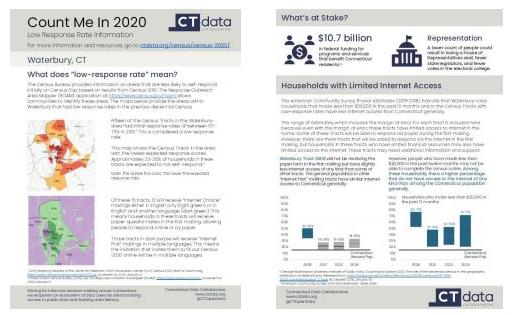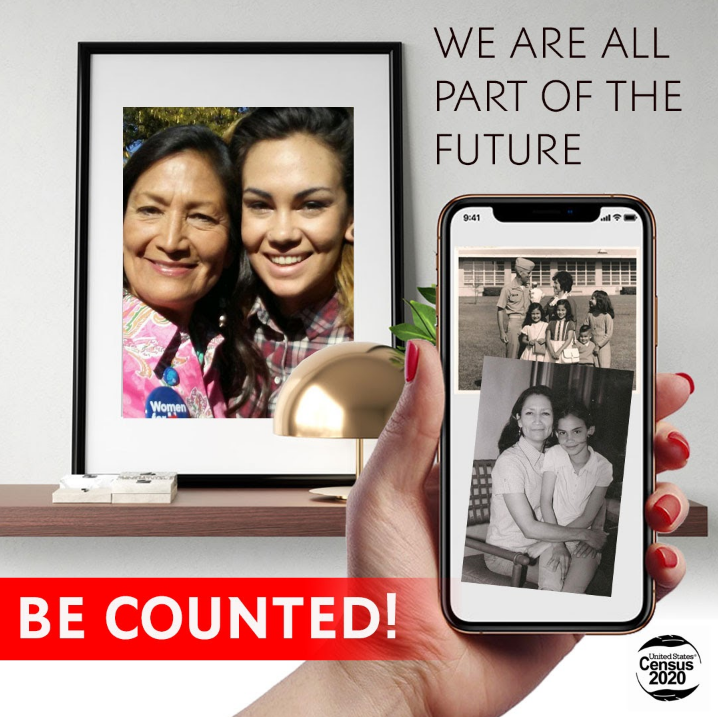Preparing for Census 2020: Resources You Can Use
$10.7 billion. That is the amount of federal funding that Connecticut receives for roads, schools, public works, and other vital assistance programs. This funding amount is based on data gathered during the 2010 decennial Census. Yes, you read that correctly. A few short questions shape funding for critical community services for the next 10 years.
With the 2020 decennial Census happening this Spring, it is important for communities to work together to make sure that everyone is counted. We rely on these dollars to support services and infrastructure within our communities. In fact, for every person not counted, Connecticut loses approximately $2,900 in funding to other states, as well as funding for important community services and infrastructure.
As the Census State Data Center, CTData is here to help disseminate accurate and timely information about the census. We know that our local complete count communities and partners are working diligently to serve under-counted communities. We are grateful for all the work you do to make sure communities know that the 2020 Census is safe, easy, and important. This is especially important since a recent survey from the Census Bureau found that 4 in every 10 respondents were not sure if they will participate in the census.
Below are a few resources to help you and your community kick off your 2020 Census outreach:
Census Bureau Outreach Materials
The U.S. Census Bureau has developed short informational videos, video and radio public service announcements, scripts, fact sheets, and brochures about the 2020 Census.
Census 2020 Awareness Campaign videos for different audiences
Census 2020 Fact Sheets in multiple languages
Educator Resources
Do you work with students? The Census Bureau has developed free activities and tools to help you engage your students with census data. To raise awareness about the 2020 Census, consider:
Posting social media content about the 2020 Census
Including the bookmark (see below) with all books checked out of the school library
Sending out an announcement to caregivers by mail and/or your electronic parent notification system
Host a Census 2020 night at your school during which caregivers can use school computers to complete their census form
Funder Resources
The Funders’ Committee for Civic Participation and United Philanthropy Forum developed a Menu of Options for Funders to participate, convene, and invest in the 2020 Census.
Historically Under-counted Communities
The Census Bureau’s Response Outreach Area Mapper (ROAM) application provides a map of which communities are historically under-counted and how each community will receive information about the 2020 Census (paper, online, and in what languages). You can find a fact sheet about how to use ROAM online here.
CTData developed one pagers to help communities understand which census tracts had low response rates during the 2010 Census and, therefore, may benefit from additional targeted outreach this year to ensure a complete count during the 2020 Census. One pagers are currently available for: Danbury, Meriden, Middletown, Norwalk, and Waterbury.
Library Resources
As part of their work with the Norwalk and Bridgeport Complete Count Committees, Norwalk 2 Bridgeport (N2B) is working with local libraries to provide a 2020 Census bookmark with every book that is checked out letting library patrons know that the census is safe, easy and important. You can download the bookmark in English and Spanish.
The American Library Association also released a guide with additional ways that libraries can be involved in the census.
Nonprofit Resources
The Connecticut Nonprofit Alliance developed a Census 2020 Toolkit that outlines the census timeline and ways to get involved in the process to ensure a complete count and funding for essential services and programs.
Posters
Across the nation, the Census Bureau is bringing together Complete Count Committee representatives, municipal readers, grassroots organizations, designers, content strategists, and media experts through Create-A-Thons to develop materials to reach under-counted communities. Here are a few examples of posters that communities are using:
Other Useful Resources
The Center on Poverty and Inequality at Georgetown Law has developed a number of fact sheets, reports, and briefs related to the 2020 Census. Topics include why the census matters for women and girls, group quarters, frequently asked questions by the disability community, environmental justice and climate action, privacy and protection, why the census matters for reproductive health, race and origin, counting people experiencing homelessness, and why the census matters for rural America.
As your Census State Data Center, CTData, is the official local resource for access to and education about census data and resources. We will keep data users abreast of updates from the Census Bureau as we continue to learn more.
How are you doing outreach about the 2020 Census? What materials have you created that other Connecticut communities can adapt and use? Email us at info@ctdata.org.






